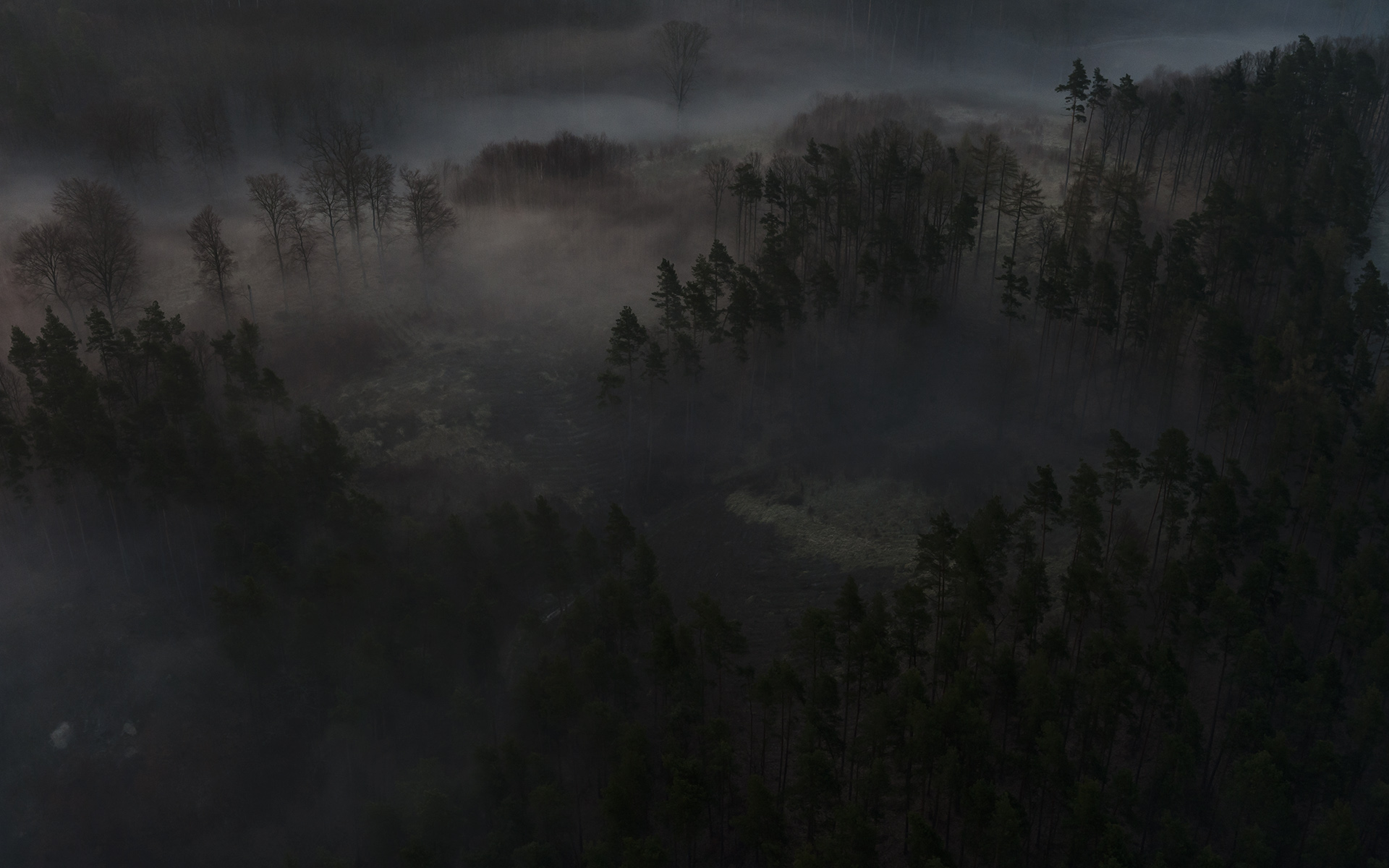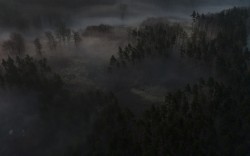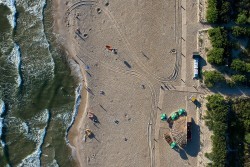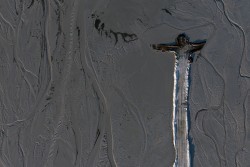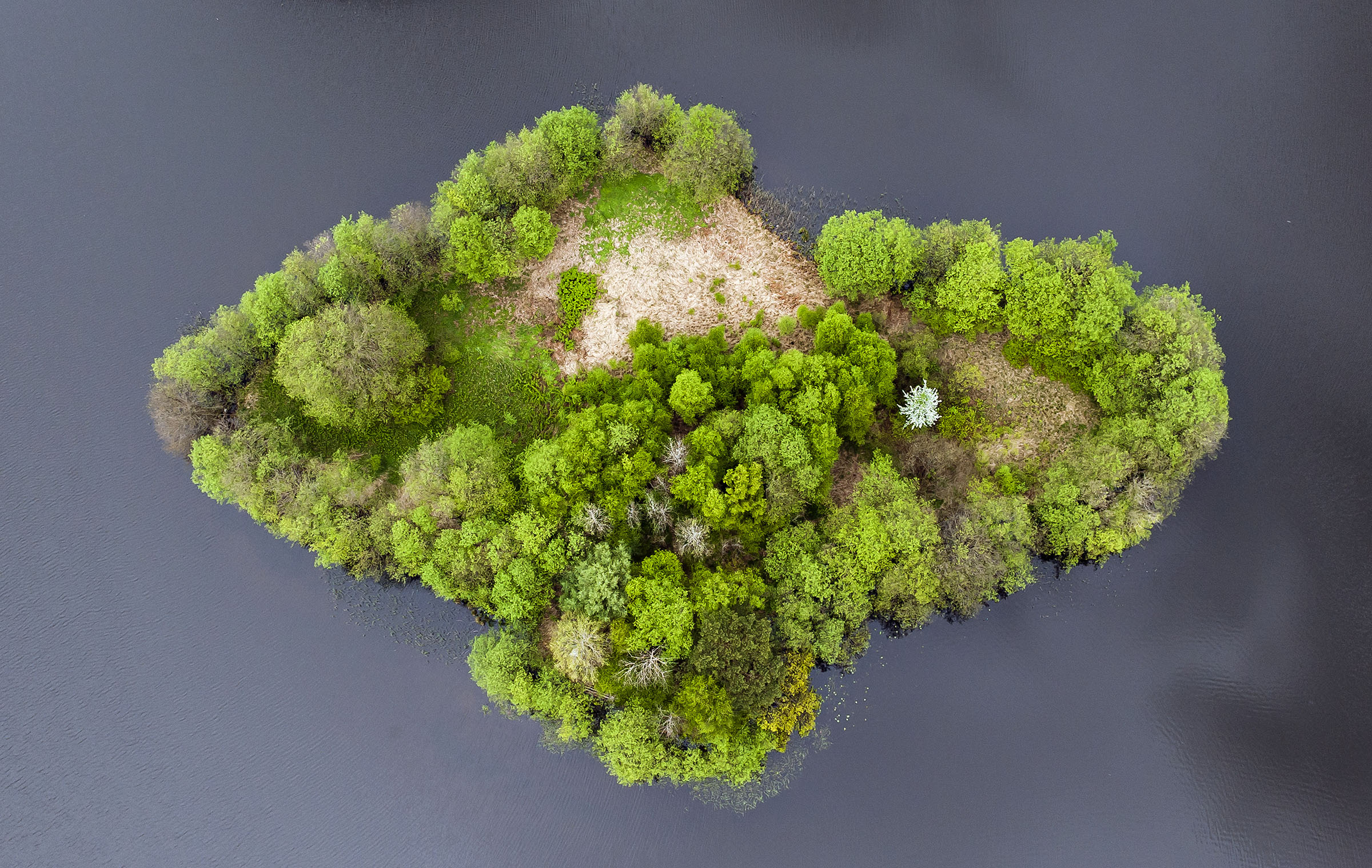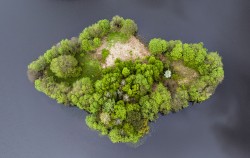Side Effects
A long-term photographic project documenting the natural human environment, it has been developing since 2007 and continues to this day.
I am a pilot and a photographer. I like flying over familiar territory. It gives me time for reflection and cautious study of the landscape. I usually fly over the Pomerania region, close to Gdańsk, my hometown. Sometimes curiosity makes me venture further, beyond the recognizable. When I return, I spot changes. I take off, pursue, watch closely and take pictures.
What interests me most in this project is answering the question: What is humans’ natural environment? Is what I see a natural scenery inhabited by people or an environment altered to suit our needs? Has the forest I’m looking at always been there or was it planted to supply timber and is no more natural than a potato field? What is the nature of nature?
I want my photographs to convey the broad spectrum of human activity. I try not to judge what I see. The photos themselves are documents, evidence in the case. I am content if they become food for thought. Much depends on who’s looking and making an assessment. An archeologist and a farmer will notice different things in a landscape. I want Side Effects to provide material for an argument on what is good and bad, necessary and optional in the relationship of human beings with nature.
Side Effects was created entirely in Poland. I thought that I don't have to go to spectacular places on the other side of the globe to get a composition illustrating the features of the human era called the Anthropocene using an unusual place. I can observe the spectacle of the action by flying in my home area, the composition is under my feet.
Side Effects It is more a method of telling the features of civilization than a specific and closed set of photographs. The project has been evolving since 2007 and consists of a series of smaller sub-projects and series that form separate stories: Seasons, Toxic Beauty, Flood from the Sky, Sun and Fun, Depth of Winter, Toys for Boys and others.
Side Effects is presented in many different forms: a photobook, gallery exhibitions, as well as a piano concert (This is the only time I have used remote-controlled technology to create still video in my artistic career to date). The music was written by Jaroslaw Kapuscinski, and the concerto has been performed live dozens of times by Jenny Q. Chai entering her repertoire. Individual photographs are provided for press illustrations. I cooperate with the British agency Panos Pictures and the Polish photo agency FORUM, Photographs have been published in press titles such as Time, Newsweek, New York Times, National Geogrpahic, News Scientist, GEO, and many other local titles.
Photographs from the project have been exhibited dozens of times in galleries, museums and photo festivals. Collectors prints are part of private and institutional collections around the world.
"Side Effects" was first shown in Germany in 2012 at the Polish Institute in Düsseldorf in the exhibition "Nebenwirkungen". In January 2014, I co-published the photobook "Side Effects" together with the Leica Gallery in Warsaw. A series of 30 photographs representing the project won second prize in the World Press Photo 2015 competition in the long-term documentary category.
The project is curated by Agnieszka Jacobson-Cielecka.
When I feel that a project is finished, there are other reasons for flight and reflection. Sometimes it is politicians who make controversial decisions that change the landscape, sometimes nature reacts to man-made changes. There are also times when I notice another feature that I have not seen before. This is both fascinating and surprising. There are no more icebergs on the sea, they have disintegrated, the ship of civilisation is sinking, the orchestra is playing.
I have written below a description of the genesis of this project. It is a bit of an autobiography, written to help me understand my own journey and the milestones along the way, the intersections with my personal and professional life, the experience of flying, technological revolutions, etc. The issue of human impact on the environment is increasingly being addressed. This is a good thing, and one of the reasons why the Side Effects project was created.
1996-2006 - Introduction,
2007-2015 - Side Effects,
2016-2024 - Side Effects 2.0
Introduction,
1996 - After graduating from high school, I started studying architecture and discovered paragliding. For the first time in my life, I took off on my own. I immediately wanted to fly as much as possible. Higher, further, longer. And since I live on the coast, I start by flying over the cliffs. When the wind from the sea is strong enough, a lift zone forms above the cliffs. When the wind dies down, I balance on the edge of the cliff, at tree level. I enjoy it. As soon as I can do more than control the flight, I start taking photographs. It's easier for me to show what I see with my own eyes than to talk about it. There are a lot of views and other paragliders in the photos from this period.
2002 - I graduate and start working as an assistant in my father's architecture studio. I spend all the money I earn on flying. I took part in the Polish Paragliding Championships. This was the beginning of my adventure with sports competitions. I start writing regularly for aviation magazines, sharing my thoughts about flying.
Once, while flying over the sea in Jastrzębia Góra, I observed the effects of a construction disaster. A cliff had collapsed, taking part of Beck's villa with it. I photographed the scene, developed the film and photos and went to the local KFP news agency. The photos brought me recognition from Maciej Kosycarz, and this situation developed into a regular collaboration. I am happy that my flying has added value.
I organised the first exhibitions about flying over cliffs. During one of them, a local developer noticed a photo of a housing estate in Gdynia Orłowo and we agreed that I would take similar photos to present his investment. As the estate is far from the cliffs, I borrow a motor from a friend to fly there. With the money I earned, I bought my own motor.
2003 - I try to combine my work as an architect with my passion for flying. I do service photography for other architects and developers. I enjoy flying with the motor more and more. I love flying at low altitudes. I feel like I'm on a magic carpet travelling at 35 km/h. When I fly slowly, I have a view that is not available in any other way. These are still analogue times and bird's eye views are rare.
2004 - When I'm in the air, everything makes me curious. The clouds, the perspective, the ground, the birds and the other pilots. Their comments, especially those of the larger pilots, make me happy. I hear in them a nostalgia for what they involuntarily miss below them when they look at the landscape in front of them.
In the autumn I go to the Pre Paragliding World Cup competition in India. I fly in the foothills of the Himalayas, where the Dalai Lama lives in exile, and high in the mountains, where there is no access and electricity is rare. I see quarries where people hand-pick slate for roofing, and corn drying on the roofs of houses. My colleagues laugh at me. We're racing seriously here and you're wandering around, instead of looking ahead you're tripping over the ground and pictures.
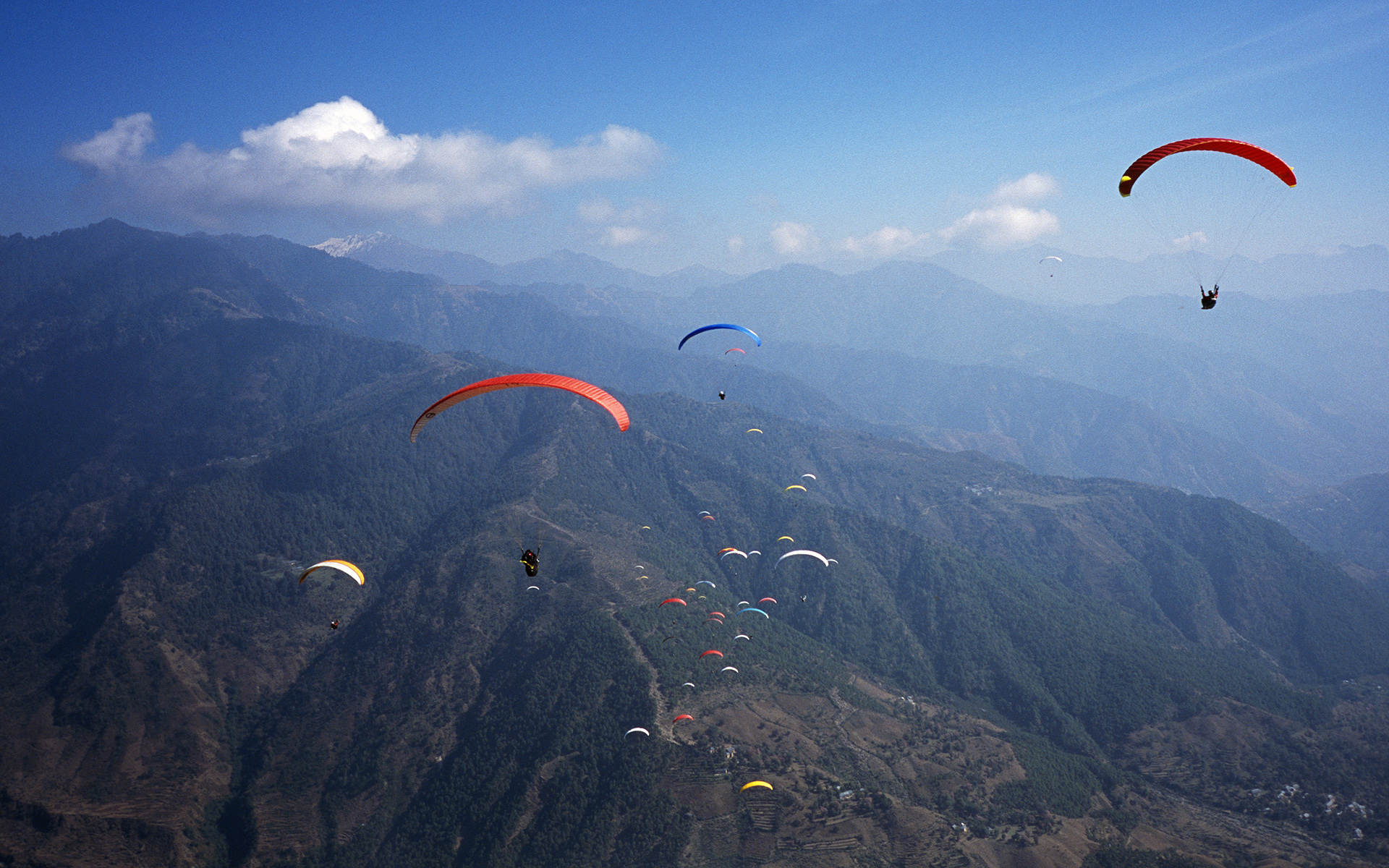
2005 - On my return from India, I realise that the excitement of flying close to home is similar. I am at home and I feel like a photographer documenting a geographical society a hundred or so decades ago. In those days, explorers simply went to the ends of the earth and returned with stories and photographs - evidence of extraordinary cultures and civilisations. I don't have to go anywhere. My gateway to the end of the world is in front of my house, on the lawn from which I start. And in my own city, I find unusual places and situations, previously unknown and undiscovered by other means of air travel.
The plane flies too fast, the angular velocity makes analogue photography much more difficult. That's why photos from the plane are taken from a higher altitude. In addition, the wings and fuselage obstruct the view. The helicopter is too expensive for Polish conditions, and there is still a belief in society that you need some kind of special permission to photograph the landscape from a bird's eye view. And it is not quite clear how to treat paragliders. Are they sports equipment or full-fledged aircraft? Where and under what conditions they can fly. Where to take off from. An interesting and unregulated time, and for me a chance to explore the white spots on the map.
Together with Marcin Ręczmin from the Gazeta Wyborcza Trójmiasto, we are organising a photo competition. "Bird's eye view of the Tricity". Every week for eight weeks we show a fragment of the city and readers guess the content of a photo puzzle. The competition is breaking records in terms of popularity and reader engagement. I feel more and more the need to combine my passion for flying and photography. I bought my first digital camera.
2006 - There is a growing inner conflict within me. When I'm supposed to be designing in the studio and the weather allows flying, I can't concentrate. I have a choice - rehab or an excuse. I find it in photography. I give up architecture for flying. I live off commissions. I photograph hotels, harbour areas and empty lots for other architects' visualisations. I offer my services to construction companies. In monthly sessions I photograph the progress of motorway and expressway work. When the photos are finished, I have fuel in the tank and the light is still good, I look around. Curiosity takes me to places I haven't seen before, places I might not have reached on my own. I look around and take pictures. I try to think of a use for my photographs and take them spontaneously during the flight, so that when I land I can offer them to the owners of the objects or to press agencies.
I look for additional opportunities that may arise from flying. I obtain my instructor's licence. Together with my friends, I set up a paragliding exploration group in Gdynia. It is the first of its kind in the world. I feel that my passion can be useful to someone.
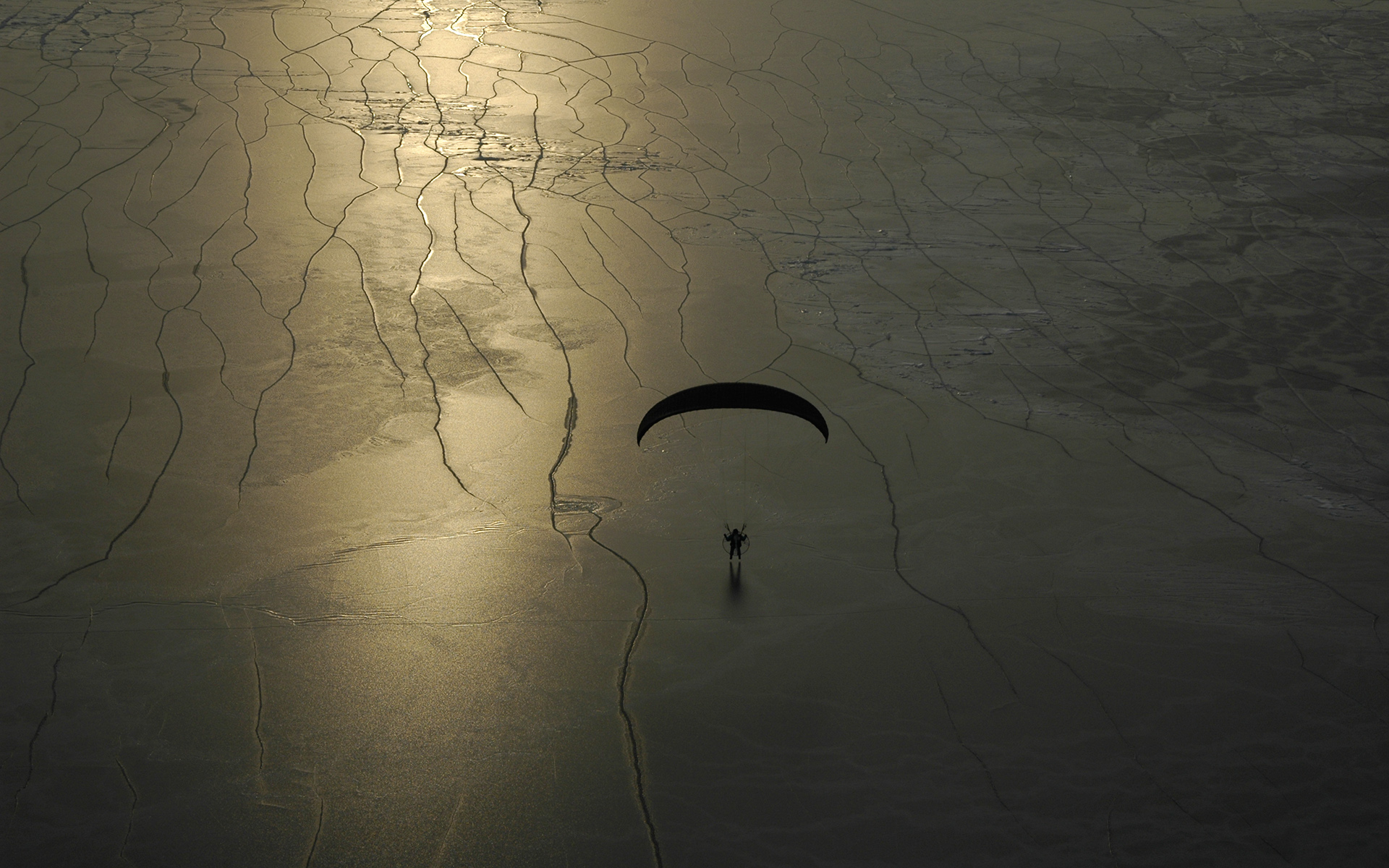
2007-2015 Side Effects 1.0
2007 - In my architectural practice, when I drew a site plan myself, I had to interpret reality, draw a tree, a building, a road. I had to draw the boundary of a wetland, for example. I look at the landscape under my feet and see drawings and sketches. I feel that architecture is still alive in me.
I feel awe flying between the woods, the hills, the buildings. I don't have to experience this state in front of a spectacular landscape. I am more and more convinced that my landscapes, which I know well from the ground, can also be astonishing to someone living on the other side of the world, for example in India. Flying in the Himalayas is spectacular and I want to return there for the sheer pleasure of flying. But photographically I want to connect with my landscape, because I feel I have a good story to discover and tell under my own feet. I make another decision. Not just vertically down, but in the place where I live, in Poland.
This is the moment when the first images for Side Effects begin to take shape, although I don't know it yet. With the digital revolution, my colleagues are trying their hand at photography. Many are trying their hand at the market. I feel the pressure and have another reason to fly more, more often, further and to develop creatively.
I am curious about people. The landscape is dead without them. I watch them relaxing on the waters of the Gulf of Gdañsk and on the beach in Władysławowo. I prepare entries for competitions. For a photo showing a fragment of a crowded beach, I wrote a long description of what happens there from morning to evening. The photo won an honourable mention in a National Geographic competition, and I decided that in the following season I would tell this story in a reportage style, without words, using the language of drawing.
2008 - I am fascinated by everything. Any manifestation of human activity. Areas that seem virgin, agriculture and forestry, roads, transport lines and what is hidden behind high fences of industrial infrastructure in places that are completely inaccessible from the ground. These aspects of human civilisation unfold in separate chapters: "Toys for Boys", "Tracklog", "Sun and Fun", "Seasons".
A photograph of a lake in a Kashubian forest wins first prize in Nikon's competition to celebrate 75 years of Nikkor lenses. In his laudation, one of the judges called it 'a landscape like never before'. I want to give this place an extra dimension and photograph it in different seasons. Just as I photograph the same place on the beach in Władysławowo, I want to photograph time.
2009 - A series entitled A Day at the Beach wins a prize in the World Press Photo competition. I received the news at a sports competition in Australia. On my return to Europe, I spoke to a representative of the competition organisers who asked me. Kacper, we've got a good wine bet here. Tell me how you make it. From a balloon? From an aeroplane? From a crane? My answer, from a paraglider in flight, is met with disbelief. But why, nobody does that! They are so well cut, so repeatable. I explain that, paradoxically, it is not complicated. I fly along the beach like a string. I wait until I have cut the line I have drawn in my imagination between the tall chimney on the horizon and the wind turbine. Nothing difficult. The basics of navigation. When I went to Amsterdam to receive the World Press Photo Award, I received extraordinary support and energy, I had a very strong feeling that the direction of my search was the right one. I'm giving it my all. And I ran towards photography.
There is a kind of code of honour between us pilot photographers. We know each other, we meet during flights and at exhibitions or competitions. We try not to take up a subject that someone else has already covered. There is so much to discover, let alone imitate in style. It's about differentiating ourselves and cultivating our own style. It comes quite naturally. The photographs come from experiencing the space, seeing with my own eyes and processing the scene through the filter of my own sensibility. Sometimes I wonder if I could make a composition with a different dynamic and harmony. Does my architectural background make me miss other images? My conclusions are perverse. I don't want to look at other people's photos and change my own method. I shy away from Instagram for fear of unconscious influence. And I do my own thing.
2010 - Agnieszka Jacobson-Cielecka invited me to participate in her Materia Prima project. It is an industrial design project presenting works by young artists from Poland and Eastern Europe. My photographs provide a context for the objects presented. I am happy to use them in this way. I see more and more threads of interpenetration between different creative fields. I have more ideas for photographs that describe the characteristics of human presence in the landscape.
Southern Poland is affected by floods. As soon as the rain stopped, I went to Sandomierz. The Vistula River was flooding the town and the surrounding villages and farmland. I photographed with an eye to the news, and when the pictures were ready, I began an in-depth reportage, a portrait of civilisation. I develop the language of abstract vision. Flying over flooded areas, I look for moving places that are symbolic and therefore readable for everyone.
Shortly after shooting in Sandomierz in the spring, I had an accident. Shortly after take-off, I fell several metres onto my back and fractured my spine. I don't think about the seriousness of the situation, only that I won't be able to fly a paramotor for at least a few months. In order not to miss a season, I am training for my gyrocopter licence and working on a plan for a commercial photo shoot for Chopin Airport, the largest airport in Poland.
During the weekends in September, the runway intersection is being renovated and the airport is operating on a limited basis. I photograph the airport and the new terminal - perspective views. And then I photograph myself, seeing the world from concrete.
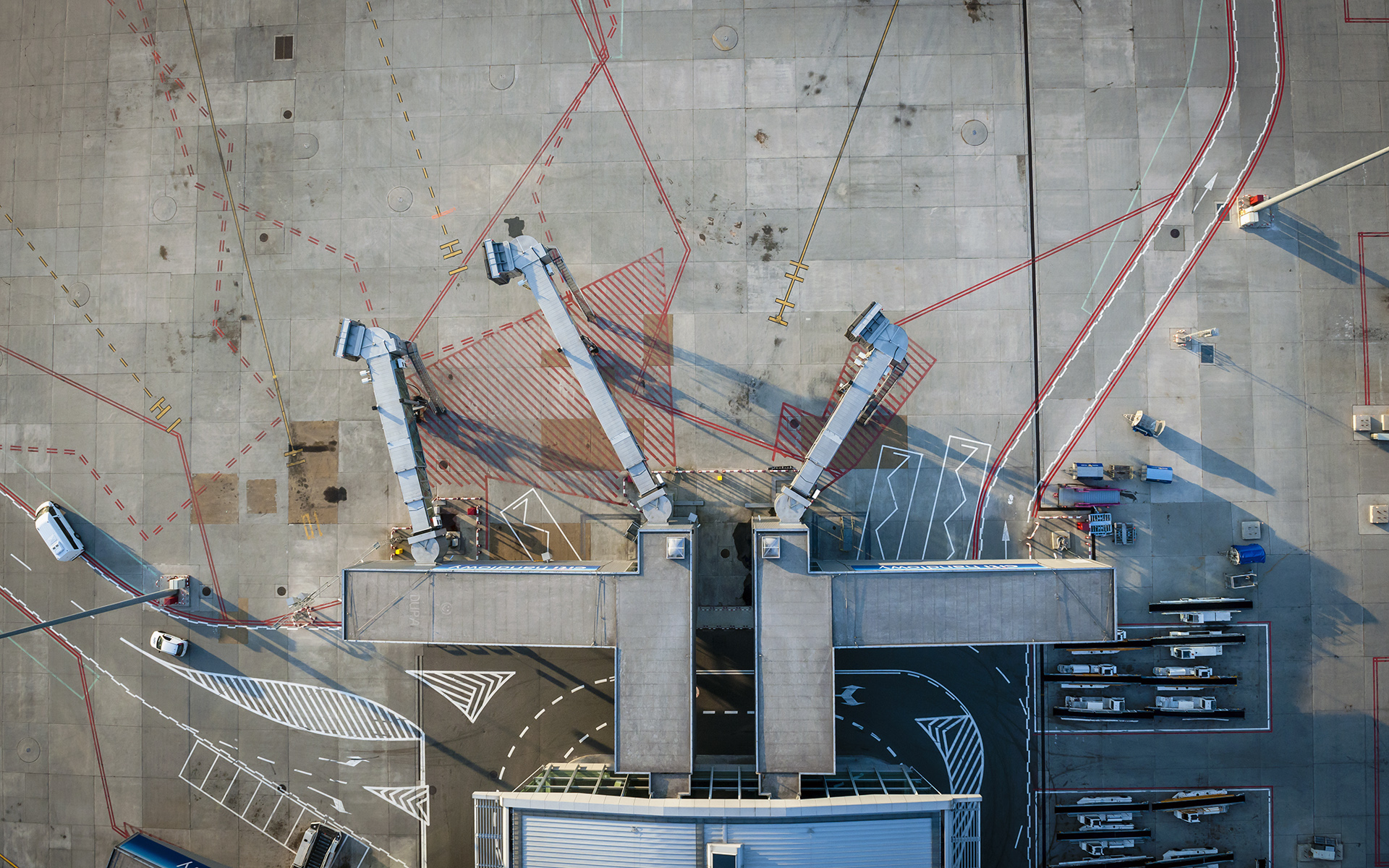
2011 - I join Panos Pictures. Michael Regnier from the agency disabused me of my ideas. He says don't expect to be given assignments with bird's eye views. The press no longer has those budgets. But the world of the press will certainly benefit from the results of your work, because photography is universal and can brilliantly illustrate the issues that the public lives by. This is also happening. My photos are increasingly appearing on the pages of the major international press magazines.
More and more often I hear people say that my pictures are more suitable for galleries than for the press. I don't understand why. A photograph is a photograph. If it's documentary, it's for the press. And if it's also suitable for a gallery wall, all the better. I start to look at galleries and collectors' photographs. At the invitation of Rafał Łochowski from the Leica Gallery, I start my first serious cooperation on the gallery market.
2012 - I cooperate with Agnieszka Jacobson Cielecka, who is preparing an exhibition in Germany at the Polish Institute in Düsseldorf under the title 'Nebenwirkungen'. The gallery is divided into several rooms. Each is thematically dedicated to a different visual representation of the human presence in the landscape. From nature to agriculture, infrastructure, heavy industry, etc. The impressions created by the juxtaposition of the photographs are very strong. Between two colourful abstract photographs there is another elusive and namable moment. An impression, perhaps. A sensibility. A visual intelligence. I like the effect of opening up the imagination. Hence, among other things, the title Side Effects. Photographs are made on different occasions, have different effects.
2013 - I am accelerating more and more. I fly as much as I can. I believe in my mission. For example, when I fly at dawn on a holiday Saturday in August, I wake up half the town with the noise of the engine. And I have an explanation. Without my effort and the social cost, the world won't know how extraordinary the moment looks from the sky. This is a metaphorical, matrix photograph, an important one. For this session I am flying in a gyrocopter. The conditions are too turbulent for me to fly a paraglider. When I look at the photos after returning to the studio, I am hard on myself. I would rather fly a paraglider with a motor. Then I could fly lower. But my glider is an old design, not suitable for flying in such conditions.
I am looking through the offers of a friendly manufacturer from Bydgoszcz, Dudek Paragliders, and I cannot find an offer for me. I feel that there is no solution for pilots like me. I mean pilots who do something else in the air, like flying, and who take many extra kilos of equipment with them. So I started working on a new design with Wojtek Domański and Piotr Dudek. Soon I received the first prototype and the phase of flying the new wing began. I have another reason to fly.
I take part in more and more exhibitions. This contributes to conversations about flying, photography and emotions. Although I have a hard time with it and prefer to hide behind the camera while flying, I am fascinated by people's reactions to the photos. Rafał Łochowski, the owner of the Leica Gallery in Warsaw, takes me to art fairs and I can observe how they interact, what happens when I use different display treatments, what happens when I reveal what is in the photographs and what happens when I leave them open to interpretation. And the exchange of energy. Taking part in fairs is hard work on the one hand, but on the other it is a great training ground for experience and an extraordinary exchange of energy.
Rafał tries to convince me that it is high time to publish a book summarising the state of the project. I shy away from the idea, convinced that I am not ready and that I am still missing many peculiarities of the human presence in the landscape. Many compositions I would like to repeat, they are not perfect. When I fly a motorised paraglider, I don't always have the best conditions. Sometimes the air is cloudy, sometimes it's completely overcast, the wind is blowing and I can't sufficiently frame what I want, the snow is melting, it's too dark, and so on. When I fly a gyrocopter, I can't go everywhere, I can't go as low as I'd like. However, Rafał convinces me that such a state can last indefinitely, and the project was already so extensive that there is enough material for several books, and this one, summarising many years of research, is enough. A team of authors was formed to work on the book. Design: Edgar Bak. Texts: Maciej Kuzmicz. Curator: Agnieszka Jacobson-Cielecka. Together we tried to translate the work of Side Effects into the medium of a book. We looked for a graphic form, a way to add a literary layer, we built sequences and narratives, and then, together with Leszek Marcinkowski, we worked on production and material solutions, respecting Rafał's financial means, who invested a lot in this still unknown production, believing that this effort made sense. It was great creative fun!
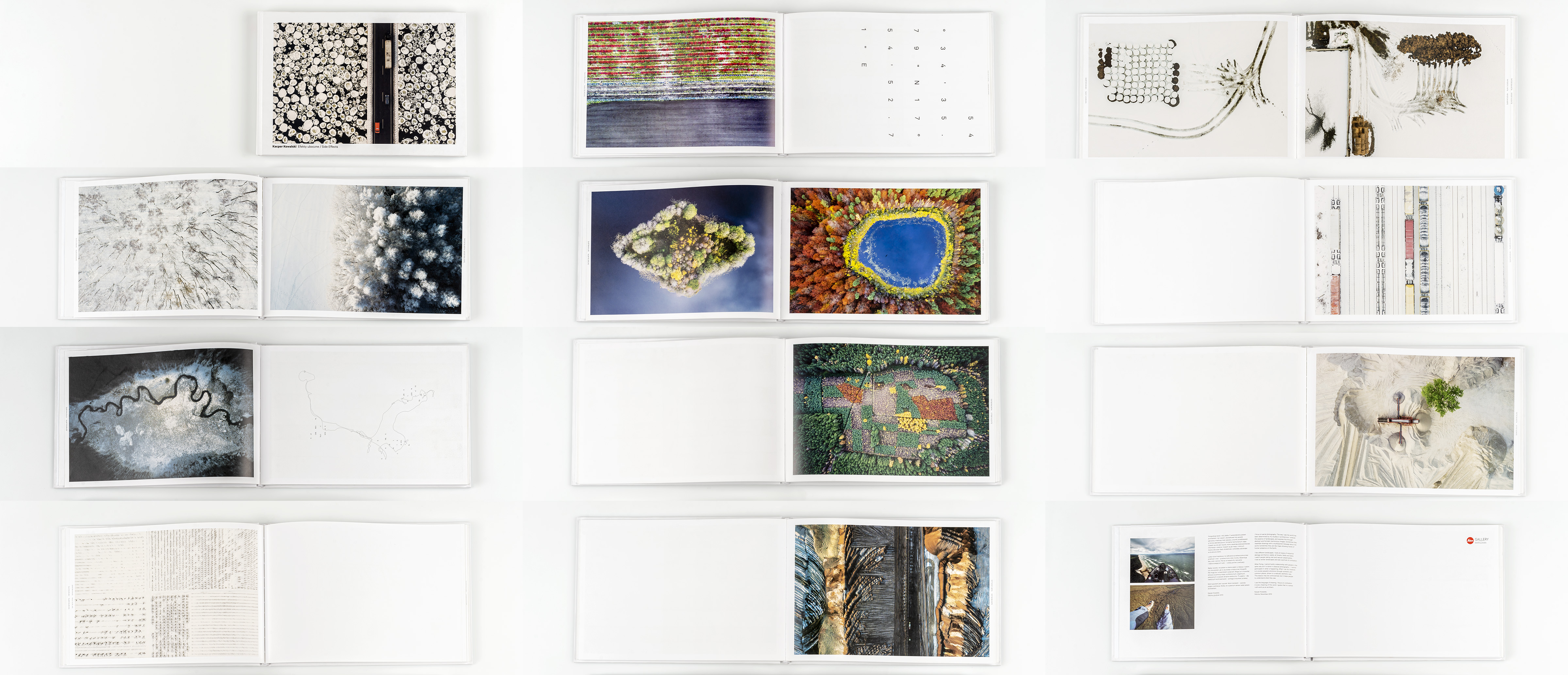
2014 - At the beginning of January, a book entitled 'Side Effects' was published by Migavka. The premiere of the book was accompanied by an exhibition of the same name, which inaugurated the opening of the Leica Gallery in Warsaw. In the spring, a series of 12 photographs from the project, a chapter entitled Toxic Beauty, which tells of the nature of the space of heavy industry, was awarded a prize in the Nature category of the World Press Photo competition. The competition exhibition will be shown in 80 cities around the world.
In Amsterdam, during a festival linked to World Press Photo, I met Edward Burtynsky. The legendary photographer and visual artist was giving a talk on his Water project. In the evening, over a beer, we discuss the changes on the doorstep of our artistic field, which is about to be revolutionised by the advent of drones. I hand him a copy of Side Effects, and it is a pleasure to hear a good word from the master.
And the news of Rafal Luckos' death hits me like a bolt from the blue. A bronze medallist at the European Paragliding Championships. Rafal died in Valle de Bravo, Mexico, during a training day on the eve of a competition in the Paragliding World Cup (PWC) series. Rafal was an incomparable role model. He flew safely, technically perfect. He was a reference - if I fly like Rafal, I'll be fine. How is that possible?

In the autumn I went to the Photoville festival in New York. There I met Bill Shapiro, the legendary head of Life magazine, and Ann S. Moore, the former CEO of Time Inc, who had retired to set up an art gallery in Chelsea. More doors open for me in the art world.
2015 - A series of 30 images from the project wins the World Press Photo Award in the long-term project category. The competition exhibition is shown in 80 cities around the world.
World Press Photo 2015, 2nd prize, long-term projects category. The project is represented by a series of 30 photographs taken in Poland between 2009 and 2014.
World Press Photo 2015
Contest narration,
Kacper Kowalski is a pilot and a photographer.'Side Effects’ is a documentary project about the complex relationship between humans and nature. The photos were shot either from a paraglider or a gyrocopter, some 150 meters above the ground, mainly in the area around Tricity, in Poland, where Kowalski lives.
In this work, Kowalski explores answers to questions that deeply interest him: What is the natural environment for humans? Is it an untouched, virgin landscape? Or is it a landscape that has changed, adapted to human needs?
Kowalski sees his work as offering a graphic and sometimes abstract portrait of how civilization came into being. For Kowalski, the content of the photo is less important than the reactions, reflections, and ideas that arise when looking at it. He would like the project to be a starting point for discussion about what is good or bad, necessary or optional, in the relationship between humans and nature.
The camera is never connected to a remote control, and Kowalski never uses a drone. He wants to be up there, camera in hand. And he flies alone. That means he doesn’t have to explain anything, or rely on another person’s spatial imagination. It means he can fly precisely.
Side Effects is more a method of visual storytelling than a concrete set of pictures. It is an ongoing project that will continue to be modified.
Amsterdam,
February 2015
2016 - After two years of flying prototypes, I had another excellent instrument, Report’Air paraglider that was easier to launch in calm weather, in knee-deep snow, with a full tank of fuel and a stabilisation system with battery and medium format camera. All this adds up to a weight of about 50kg. I carry it all on my back. A new paraglider would allow me to fly more efficiently and safely. The truth is that my range has increased. I have flown more often and in more difficult conditions.
The world of aerial photography is also changing. With drones, the scale of enthusiasts for this type of photography is changing. More and more often I see my compositions signed with a different name. I understand that the drone operator is standing on the ground and doesn't see the world with his own eyes, only through his phone screen, and that he has to get his inspiration from somewhere. The immense satisfaction is balanced by the feeling of no longer being needed. The mission is over. I feel a sense of dissonance. I have the scout gene in me and I am still drawn to the air.
More sad news. Piotr Krupa is dead. A multiple world champion in powered paragliding and an artistic photographer. Piotr died during a training flight.
I am starting a collaboration with Professor Jarosław Kapuściński, composer and audiovisual artist, dean of the composition department at Stanford University in California. I was inspired by an exhibition at the Gdynia City Museum in 2015. The professor came up to me and said: "Your exhibition moves me deeply. The picture evokes music in my imagination. I want to write a concerto. What do you think?" This is the time when I experiment with drones. Why should I risk my own health and life when I can send a drone to shoot a video that expands my possibilities? I remember situations where the scene to be photographed was just begging to be filmed. Or I fly as I used to, observe and go to the location to film the shots. The first performance of Side Effects will take place in 2017 at the Spoleto Music Festival in Charleston, USA. The composition becomes part of Chinese pianist Jenny Q. Chai's repertoire and is performed in concerts around the world. So began our long collaboration with Jarek, although the drone didn't stay in my hands for long. I have to be in the air and see the wind with my own eyes before I press the shutter.
Although I still photograph traces of human presence, it is the emotions that come out first. I try to work through a crisis situation in subsequent projects. I ask myself what it is about flying that I need to be at the top to see. This is how the projects OVER, Arche and Event Horizon came about. And there is another book in the pipeline called Side Effects 2.0.
Side effects: Before your first flight, please study the stories of aviators or consult an old pilot. You may lose your life, health or loved ones. Most likely, flying will change your life, as it is an incurable condition.
AWARDS & HONOURABLE MENTIONS FOR THE ENTIRE PROJECT AND ALL ITS EMANATIONS
- Pictures Of the Year International (76 POYi) | award of excellence 'Enviromental Policy' | 2019
- Pictures Of the Year International (73 POYi) | award of excellence 'Side Effects' | 2016
- World Press Photo 2015 | 2nd prize, long term project 'Side Effects'| 2015
- Pictures Of the Year International (72 POYi) | finalist, photobook 'Side Effects' | 2015
- PDN Photo Annual 2015 | photobook 'Side Effects' | 2015
- Grand Press Photo 2015 | 2nd prize, single | nature | 2015
- World Press Photo 2014 | 2nd prize, story 'Toxic Beauty' | nature | 2014
- Pictures Of the Year International (71 POYi) | 3nd prize, story 'the Depth of Winter' | nature | 2014
- Sony World Photography Awards | 2nd prize, story 'the Depth of Winter' | landscape | 2014
- Grand Press Photo | 1st prize , 'Toxic Beauty' story | nature | 2014
- BZ WBK Press Photo | 2nd prize, story 'the Depth of Winter' | nature | 2014
- Moscow International Foto Awards | 3nd prize, book Side Effects | nature | 2014
- Best of Photojournalism (NPPA) | 3rd prize, single | feature | 2013
- Grand Press Photo | 1st prize, single | sport | 2013
- Gdańsk Press Photo | honourable mention, single | outside the region | 2013
- Gdańsk Press Photo | 1st prize, single | dialy life | 2013
- Pictures Of the Year International (69 POYi) | 3nd prize, story, Toxic Beauty | nature | 2013
- Emirates Photography Competition | 1st prize, single | nature | 2013
- BZ WBK Press Photo | 1st prize, Toxic Beauty story | nature | 2013
- Grand Press Photo | 2nd prize, story | nature | 2013
- Leica Oskar Barnack Award | shortlisted 'Flood from the sky – Sandomierz 2010' story | 2011
- Grand Press Photo | 1st prize, story | nature | 2011
- Gdańsk Press Photo | Grand Prix 2011 | 2011
- Gdańsk Press Photo | honourable mention | Outside the region | 2011
- BZ WBK Press Photo | 2nd prize, story | nature | 2011
- Press Picture of the Year KFP | nomination | single | 2011
- International Photography Award (IPA) | 2nd prize | architecture | 2011
- International Photography Award (IPA) | honourable mention | nature | 2010
- Sony World Photography Awards | nomination, 'plus minus' series | 2010
- Sony World Photography Awards | nomination, 'toxic beauty' series | 2010
- Sony World Photography Awards | nomination, 'tracklog' series | 2010
- BZ WBK Press Photo | 1st prize, story | nature | 2010
- Gdańsk Press Photo | honourable mention | Outside the region 2010
- Gdańsk Press Photo | 1st prize, story | civilisation | 2010
- World Press Photo | 2nd prize story | Arts and Entertainment | 2009
- Nikon Photo Contest International | 75TH NIKKOR ANNIVERSARY AWARD | single | 2009
- International Photography Awards IPA | Nature Photographer of the Year | 2009
- International Photography Awards IPA | 1st prize | nature | 2009
- International Photography Awards IPA | 2nd prize | nature | 2009
- International Photography Awards IPA | 3rd prize | pecials | 2009
- International Photography Awards IPA | 20 x honourable mentions | 2009
- Grand Press Photo | 2nd prize | nature | 2009
- Grand Press Photo | 3rd prize | nature | 2009
- Press Picture of the Year KFP | nomination | single | 2009
- BZWBK Press Photo | 3rd prize | nature | 2009
- Gdańsk Press Photo | 1st prize, story and honourable mention | civilisation | 2009
- Album for Gdańsk | II International Photography Contest | award | 2009
- Album for Gdansk | I International Photography Contest | award | 2008
- Pilsner Urquell International Photography Awards IPA | 9 x honourable mention | 2008
- Gdańsk Press Photo | 1st prize, story and honourable mention | civilisation | 2008
- National Geographic Poland | honourable mention, single | 2007
- Gdansk Press Photo | honourable mention | 2007
- BZWBK Press Photo | 3rd prize , nature | 2006
- Gdańsk Press Photo | 1st prize, story | civilisation | 2006
SELECTED EXHIBITIONS
- Side Effects | PHOTO BASEL | ARTE Giani Basel, Switzerland | June 2022
- Blick von oben - Wasser und Schnee | (with Werner Klotz) Arte Giani | Frankfurt, Germany | Sept-Oct 2021
- OVER, Side Effects | AIPAD | ATLAS GALLERY | NEW YORK CITY | USA | 2019.04
- OVER, Side Effects | GOOGLE GALLERY - Los Angeles HQ Office | GALERIE XII | USA | 2019.03-05
- Side Effects & OVER | Galerie XII | Los Angeles | USA 2018
- Side Effects | OVER | Art Elysées - Art & Design | Photo12 Galerie | Paris, France | 2018.10
- Side Effects @ TERRA VIVENTE | Velathri Art Gallery | Borgo Pignano, Włochy | 2017
- Side Effects | International Bienniale of Photography | Bogota, Colombia | 2017
- Side Effects Concert | Spoleto Festiwal | Charleston, USA | 2017
- Herbst & Winter | Arte Giani | Frankfurt, Germany | 2017
- Artist of the Year | The Curator Gallery | New York City, USA | 2017
- Artist of the Year | The Curator Gallery | New York City, USA | 2016
- Side Effects | Muzeum Ziemi Chełmińskiej | Chełmno, Poland | 2016
- Fade to White | The Curator Gallery | New York City, USA | 2016
- SALON ZÜRCHER | Zurcher Gallery | Paris, France | 2016
- Wings of Fantasy New European Photography | Millennium Monument | Beijing, China | 2016
- Side Effects | group exhibition in Hillerod Art Society | Hillerod, Danemark | 2016
- Above and Beyond | The Curator Gallery | New York City, USA | 2015
- Side Effects | Leica Gallerie Salzburg | Austria | 2015
- Side Effects | The Lumiere Brothers Center for Photography | Moscow, Russia | 2015
- Side Effects | Arte Giani | Frankfurt, Germany | 2015
- Side Effects | Muzeum of Gdynia | Gdynia, Poland | 2015
- over 80 World Press Photo exhibitions arround the World | 2015
- Side Effects | Leica Gallery Warsaw | Warsaw, Poland | 2014
- Side Effects | Photoville Festival | New York City, USA | 2014
- Materia Prima | Kauno Kolegija | Kowno, Lithuania | 2014
- Materia Prima | Museum of Applied Arts | Vilnius, Lithuania | 2014
- over 80 World Press Photo exhibitions arround the World | 2014
- Materia Prima | Klaipedos kulturu komunikaciju centro parodu rumai | Klaipeda, Latvia | 2013
- Materia Prima | Munnkerupkus House | Copenhagen, Danemark | 2013
- Nebenwirkungen | Polish Institute | Dusseldorf, Germany | 2012
- At the Other Side of the Baltic Sea | House of Europe | Stockholm, Sweden | 2011
- Flood From the Sky | Leica Gallery | Warsaw, Poland | 2011
- Harsh Winter | Pauza gallery | Kraków, Poland | 2011
- Flood From the Sky | constance exhibition in Snadomierz, Poland | 2011
- At the Other Side of the Baltic Sea | European Comission | Helsinki, Finland | 2011
- Poland Has a LOT to Offer | Polish embassy in the Prague, Czechia | 2011
- Flood from the Sky | outdoor exhibition in Sandomierz, Poland | 2010
- Materia prima | Galeria Bielska BWA, Poland | 2010
- Polska on air | Waterfront Hall | Belfast, Ireland | 2010
- over 80 World Press Photo exhibitions arround the World | 2009
SELECTED PUBLICATIONS AND REVIEWS
- Bant magazine Universal stories, local landscapes | by Yetkin Nural
- Loeil de photographie Kacper Kowalski: I see the ground through the architect’s eyes. | by Bill Shapiro
- Fast Company These Bleak Winter Photos Imagine A World Without Humans | by Adele Peters
- Elizabeth Avedon Journal review
- Architectural Digest STEFANIE WALDEK about Fade To White exhibition
- Gazeta Wyborcza | Trójmiasto Polisą ubezpieczeniową pilota jest strach
- Feature Shoot ASTONISHING PHOTOS OF POLAND FROM ABOVE
- PDN Above And Beyond: Bill Shapiro on Kacper Kowalski
- New York Times Instagram
- Audubon Turning Poland's Vistula River Into a Shipping Superhighway | by Raillan Brooks
- Newsweek Polska Sztuka latania - tekst: Sebastian Łupak
- TIME See Breathtaking Aerial Views of Fall Foliage | by Mia Tramz
- TIME OUT THERE - See Stunning Photos of the Earth from Above | by Richard Conway
- POLITYKA Ojczyzna widziana z góry - Fotolotnia - Kuba Dąbrowski
- Xiegarnia.pl recenzja Efektów Ubocznych | Filip Springer- Lekcja pokory
- Wysokie Obcasy Ma oko jak Kacper Kowalski - Magdalena Gorlas
- Gazeta Wyborcza | Trójmiasto Porzuciłem zawód z piedestału na rzecz latania i fotografowania
- Tygodnik Powszechny FILIP SPRINGER - LUBIĘ PATRZEĆ Z GÓRY
- GUP Magazine SIDE EFFECTS / EFEKTY UBOCZNE | recenzja KATHERINE OKTOBER MATTHEWS
- Gazeta.pl WEEKEND fotograf, który żyje w powietrzu - Michał Gostkiewicz
- Digital Camera Polska "Efekty uboczne" - fotografia lotnicza w Leica Gallery | Krzysztof Mularczyk
- New York TIMES In Poland, an Architect’s-Eye View By Kerri MacDonald
- Wprost Zachwyt i przerażenie - rozmowa o powodzi w Sandomierzu
- Gazeta Wyborcza Powódź piękna i przerażająca





